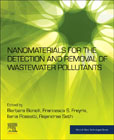
Nanomaterials for the Detection and Removal of Wastewater Pollutants
Bonelli, Barbara
Freyria, Francesca S.
Rossetti, Ilenia
Sethi, Rajandrea
Nanomaterials for the Detection and Removal of Wastewater Pollutants assesses the role of nanotechnology and nanomaterials in improving both the detection and removal of inorganic and organic contaminants from wastewater that originates from municipal and industrial plants. The book covers how nanotechnology is being used to remove common contaminants, including dyes, chlorinated solvents, nitrites/nitrates, and emerging contaminants, such as pharmaceuticals, personal care products and pesticides. Sections cover nanofiltration, adsorption and remediation. Nanomaterial immobilization recovery is also addressed, along with the quantification of heat/mass transport limitations, sizing aspects and transport phenomena. Finally, regulatory aspects regarding contaminants and nanoparticles in the environment are covered. This book is an important resource for both materials scientists and environmental scientists looking to see how nanotechnology can play a role in making wastewater a less hazardous part of the global ecosystem. Addresses the role of new nanotechnology-based solutions for the detection and removal of common and emerging contaminantsDiscusses the environmental impact of nanoparticles used in wastewater contaminant detection and removalExplores the major challenges for using nanomaterials to detect and remove contaminants from wastewater INDICE: 1. Nanotechnologies and Nanomaterials: basic principles and possible role in wastewater remediation 2. Nanomaterials: a tool for remediation or another class of emerging contaminants? 3. Common wastewater contaminants versus emerging ones: an overview 4. Detection methods of wastewater contaminants: state of the art and the role of nanotechnology 5. Detection and removal of biological contaminants: the role of nanotechnology 6. Nanomaterials for the efficient abatement of wastewater contaminants by means of reverse osmosis and nanofiltration 7. Advanced nanomaterials for ultrafiltration membranes application 8. Adsorption processes for the removal of contaminants from wastewater: the perspective role of nanomaterials and nanotechnology 9. Advanced nanomaterials for the removal of heavy metals 10. Magnetic nanoparticles for wastewater remediation 11. Heterogeneous catalysis: how nanotechnology and nanomaterials can improve the performance in wastewater remediation 12. Heterogeneous (photo)Fenton reaction and its enhancement upon addition of chelating agents 13. The role of nanotechnology and nanomaterials in the electrocatalytic abatement of wastewater contaminants 14. Actual mineralization versus partial degradation of wastewater contaminants 15. Modelling of nanoparticles dispersion, transport and deposition in different media 16. Ecodesign of Nanomaterials for Environmental Remediation 17. Matching Nanotechnologies with Reactor Scale Up 18. Economic and Regulatory Aspects related to Water Remediation using Nanotechnology
- ISBN: 978-0-12-818489-9
- Editorial: Elsevier
- Encuadernacion: Rústica
- Páginas: 550
- Fecha Publicación: 01/06/2020
- Nº Volúmenes: 1
- Idioma: Inglés
